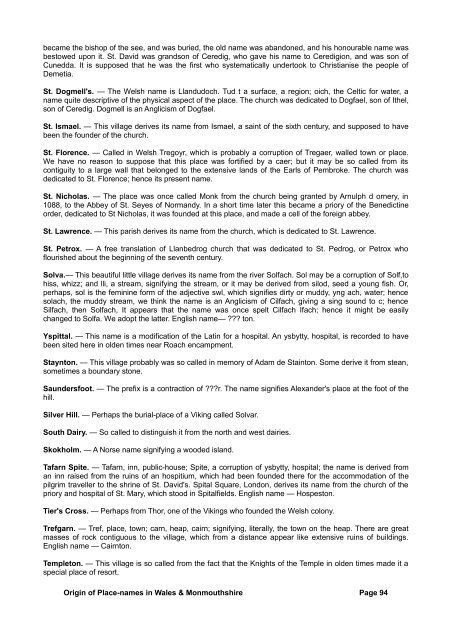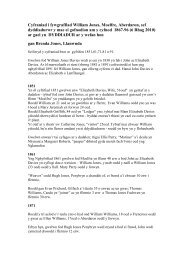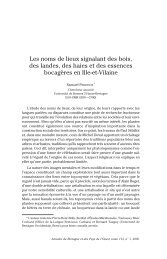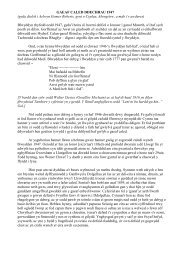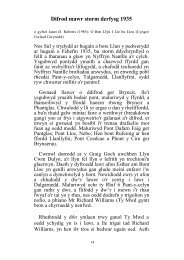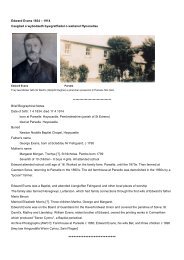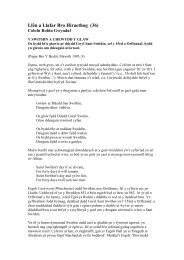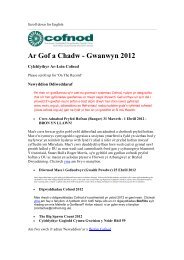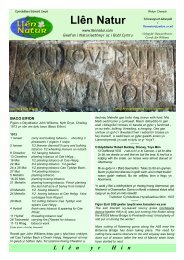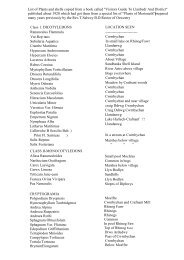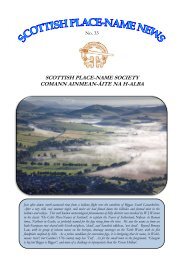Nolton. — Nol is supposed to be a contraction <strong>of</strong> Oliver; hence <strong>the</strong> name means Oliver's town.New Moat. — So called from <strong>the</strong> Flem<strong>in</strong>gs hav<strong>in</strong>g constructed a new moat here <strong>in</strong> <strong>the</strong> time <strong>of</strong> Henry II.Newport. — The Welsh name is Trefdraeth, which, signifies " a town on <strong>the</strong> s<strong>and</strong>s," from its situation near as<strong>and</strong>y beach <strong>of</strong> considerable extent. Six or seven <strong>place</strong>s <strong>in</strong> <strong>the</strong> United K<strong>in</strong>gdom bear <strong>the</strong> name Newport. Itwas wisely proposed sometime ago to change Newport, Monmouth, to Uskport. We would strongly advise<strong>the</strong> corporation <strong>of</strong> Trefdraeth to ab<strong>and</strong>on <strong>the</strong> name Newport, <strong>and</strong> give it <strong>the</strong> right English name — Beachton .Newcastle. — There is an ancient mound near <strong>the</strong> church called " <strong>the</strong> Castle," which was called " new " todist<strong>in</strong>guish it from a much older one, which is at a short distance from <strong>the</strong> village.Pelcwm. — From Pela, <strong>the</strong> titmouse; <strong>and</strong> cwm, valley. English name — Titcombe.Penybryn. — The name signifies a <strong>place</strong> on <strong>the</strong> top <strong>of</strong> <strong>the</strong> hill. English name — Tophill.Pope Hill. — The lower part <strong>of</strong> <strong>the</strong> county was once designated Pebydiog, popedom, because St. David wasconsidered as <strong>the</strong> pope <strong>of</strong> <strong>the</strong> district.Pater, or Pembroke Dock. — This <strong>place</strong> once consisted only <strong>of</strong> a farm, one house, <strong>and</strong> a church, <strong>the</strong>ndesignated Paterchurch. In 1812 surveys were made, <strong>and</strong> <strong>in</strong> two years after <strong>the</strong> nucleus <strong>of</strong> <strong>the</strong> presentGovernment was formed, when it was called Pembroke Dock.Penally. — Pen, head; ally, a corruption <strong>of</strong> gelly, a .grove; signify<strong>in</strong>g <strong>the</strong> head <strong>of</strong> <strong>the</strong> grove. The church issituated <strong>in</strong> a thickly-wooded <strong>place</strong>. English name — Groveshead.Pontfaen. — Pont, bridge; faen-maen, stone. Perhaps faen is a corruption <strong>of</strong> Gwaen, <strong>the</strong> name <strong>of</strong> <strong>the</strong> riverthat flows through <strong>the</strong> parish; f be<strong>in</strong>g changed <strong>in</strong>to g for <strong>the</strong> sake <strong>of</strong> euphony. English name — Stonebridge.Prendergast. — This <strong>place</strong> derives its name from a Demetian family <strong>of</strong> <strong>the</strong> name, who were <strong>the</strong> owners <strong>of</strong><strong>the</strong> l<strong>and</strong> <strong>in</strong> olden times. Maurice de Prendergast was <strong>the</strong> last member <strong>of</strong> <strong>the</strong> family that lived here. Someth<strong>in</strong>k <strong>the</strong> name is a Saxonized form <strong>of</strong> Bryn y Gest. Bryn, a hill; y, <strong>the</strong>; gest-cest, a deep glen between twomounta<strong>in</strong>s hav<strong>in</strong>g but one open<strong>in</strong>g. O<strong>the</strong>rs say it is Pren-dwr-gwest, <strong>the</strong> <strong>in</strong>n by <strong>the</strong> tree near <strong>the</strong> water. Theright word<strong>in</strong>g is probably Pen-dre-gast. The suffix is Druidic. Llech-yr-ast, <strong>in</strong> Cardiganshire, consists <strong>of</strong> five-cist faen, stone chests or cells, enclosed with<strong>in</strong> a circle <strong>of</strong> rude stone pillars.Puncheston. — Camael, <strong>the</strong> Welsh name, is a compound <strong>of</strong> Castell, castle; <strong>and</strong> Maelog, or more probablyMaelgwyn — Maelgwm Fychan. The " Myvyrian " calls it Castell Mal. Some derive <strong>the</strong> English name fromp<strong>in</strong>can, p<strong>in</strong>e tree; P<strong>in</strong>canes-tun, <strong>the</strong>n Puncheston, <strong>the</strong> town <strong>of</strong> <strong>the</strong> p<strong>in</strong>e trees. O<strong>the</strong>rs derive it from Peyntz, aproper name, pronounced Punches.Roach. — A mutation <strong>of</strong> rock, from <strong>the</strong> castle be<strong>in</strong>g perched on a solitary rock st<strong>and</strong><strong>in</strong>g out <strong>of</strong> <strong>the</strong> pla<strong>in</strong>. Thefirst possessor <strong>of</strong> <strong>the</strong> castle is supposed to have been Adam de Rupe, or Adam <strong>of</strong> <strong>the</strong> Rock, <strong>in</strong> <strong>the</strong> reign <strong>of</strong>Henry I. The Roche family held possession <strong>of</strong> <strong>the</strong> castle until <strong>the</strong> reign <strong>of</strong> Henry VI., when <strong>the</strong>ir extensiveestates were divided between two co-heiresses, s<strong>in</strong>ce which time it is supposed to have been ab<strong>and</strong>oned asa residence. English name— Rockby.Rhosmarket. — Rhos, <strong>the</strong> name <strong>of</strong> <strong>the</strong> cantrev. A market was once held here; hence <strong>the</strong> market for Rhos.Rhos is spelt Roos, Roose, <strong>and</strong> Rouse by English writers.Rhydgwilym. — The Rev. William Jones was <strong>the</strong> first Baptist m<strong>in</strong>ister <strong>of</strong> <strong>the</strong> <strong>place</strong>, <strong>and</strong> hav<strong>in</strong>g performed<strong>the</strong> rite <strong>of</strong> Baptism for <strong>the</strong> first time <strong>in</strong> <strong>the</strong> river, <strong>the</strong> spot was called after him Rhydgwilym. English name —Williamsford.Reynoldston. — So called <strong>in</strong> honour <strong>of</strong> Reynold, a Flem<strong>in</strong>g, who probably settled here <strong>in</strong> <strong>the</strong> reign <strong>of</strong> HenryI.Rogeston. — From Roger, ano<strong>the</strong>r Flem<strong>in</strong>g, who took up his abode here.St. David's. — A free translation <strong>of</strong> <strong>the</strong> Welsh Tyddewi, so called <strong>in</strong> honour <strong>of</strong> Dewi, David, <strong>the</strong> patron sa<strong>in</strong>t<strong>of</strong> Wales. Its ancient name was Mynywy, jutt<strong>in</strong>g, pen<strong>in</strong>sulated; but after St. David removed <strong>the</strong>re, <strong>and</strong>Orig<strong>in</strong> <strong>of</strong> Place-<strong>names</strong> <strong>in</strong> Wales & Monmouthshire Page 93
ecame <strong>the</strong> bishop <strong>of</strong> <strong>the</strong> see, <strong>and</strong> was buried, <strong>the</strong> old name was ab<strong>and</strong>oned, <strong>and</strong> his honourable name wasbestowed upon it. St. David was gr<strong>and</strong>son <strong>of</strong> Ceredig, who gave his name to Ceredigion, <strong>and</strong> was son <strong>of</strong>Cunedda. It is supposed that he was <strong>the</strong> first who systematically undertook to Christianise <strong>the</strong> people <strong>of</strong>Demetia.St. Dogmell's. — The Welsh name is Ll<strong>and</strong>udoch. Tud t a surface, a region; oich, <strong>the</strong> Celtic for water, aname quite descriptive <strong>of</strong> <strong>the</strong> physical aspect <strong>of</strong> <strong>the</strong> <strong>place</strong>. The church was dedicated to Dogfael, son <strong>of</strong> I<strong>the</strong>l,son <strong>of</strong> Ceredig. Dogmell is an Anglicism <strong>of</strong> Dogfael.St. Ismael. — This village derives its name from Ismael, a sa<strong>in</strong>t <strong>of</strong> <strong>the</strong> sixth century, <strong>and</strong> supposed to havebeen <strong>the</strong> founder <strong>of</strong> <strong>the</strong> church.St. Florence. — Called <strong>in</strong> Welsh Tregoyr, which is probably a corruption <strong>of</strong> Tregaer, walled town or <strong>place</strong>.We have no reason to suppose that this <strong>place</strong> was fortified by a caer; but it may be so called from itscontiguity to a large wall that belonged to <strong>the</strong> extensive l<strong>and</strong>s <strong>of</strong> <strong>the</strong> Earls <strong>of</strong> Pembroke. The church wasdedicated to St. Florence; hence its present name.St. Nicholas. — The <strong>place</strong> was once called Monk from <strong>the</strong> church be<strong>in</strong>g granted by Arnulph d ornery, <strong>in</strong>1088, to <strong>the</strong> Abbey <strong>of</strong> St. Seyes <strong>of</strong> Norm<strong>and</strong>y. In a short time later this became a priory <strong>of</strong> <strong>the</strong> Benedict<strong>in</strong>eorder, dedicated to St Nicholas, it was founded at this <strong>place</strong>, <strong>and</strong> made a cell <strong>of</strong> <strong>the</strong> foreign abbey.St. Lawrence. — This parish derives its name from <strong>the</strong> church, which is dedicated to St. Lawrence.St. Petrox. — A free translation <strong>of</strong> Llanbedrog church that was dedicated to St. Pedrog, or Petrox wh<strong>of</strong>lourished about <strong>the</strong> beg<strong>in</strong>n<strong>in</strong>g <strong>of</strong> <strong>the</strong> seventh century.Solva.— This beautiful little village derives its name from <strong>the</strong> river Solfach. Sol may be a corruption <strong>of</strong> Solf,tohiss, whizz; <strong>and</strong> lli, a stream, signify<strong>in</strong>g <strong>the</strong> stream, or it may be derived from silod, seed a young fish. Or,perhaps, sol is <strong>the</strong> fem<strong>in</strong><strong>in</strong>e form <strong>of</strong> <strong>the</strong> adjective swl, which signifies dirty or muddy, yng ach, water; hencesolach, <strong>the</strong> muddy stream, we th<strong>in</strong>k <strong>the</strong> name is an Anglicism <strong>of</strong> Cilfach, giv<strong>in</strong>g a s<strong>in</strong>g sound to c; henceSilfach, <strong>the</strong>n Solfach, It appears that <strong>the</strong> name was once spelt Cilfach Ifach; hence it might be easilychanged to Solfa. We adopt <strong>the</strong> latter. English name— ??? ton.Yspittal. — This name is a modification <strong>of</strong> <strong>the</strong> Lat<strong>in</strong> for a hospital. An ysbytty, hospital, is recorded to havebeen sited here <strong>in</strong> olden times near Roach encampment.Staynton. — This village probably was so called <strong>in</strong> memory <strong>of</strong> Adam de Sta<strong>in</strong>ton. Some derive it from stean,sometimes a boundary stone.Saundersfoot. — The prefix is a contraction <strong>of</strong> ???r. The name signifies Alex<strong>and</strong>er's <strong>place</strong> at <strong>the</strong> foot <strong>of</strong> <strong>the</strong>hill.Silver Hill. — Perhaps <strong>the</strong> burial-<strong>place</strong> <strong>of</strong> a Vik<strong>in</strong>g called Solvar.South Dairy. — So called to dist<strong>in</strong>guish it from <strong>the</strong> north <strong>and</strong> west dairies.Skokholm. — A Norse name signify<strong>in</strong>g a wooded isl<strong>and</strong>.Tafarn Spite. — Tafarn, <strong>in</strong>n, public-house; Spite, a corruption <strong>of</strong> ysbytty, hospital; <strong>the</strong> name is derived froman <strong>in</strong>n raised from <strong>the</strong> ru<strong>in</strong>s <strong>of</strong> an hospitium, which had been founded <strong>the</strong>re for <strong>the</strong> accommodation <strong>of</strong> <strong>the</strong>pilgrim traveller to <strong>the</strong> shr<strong>in</strong>e <strong>of</strong> St. David's. Spital Square, London, derives its name from <strong>the</strong> church <strong>of</strong> <strong>the</strong>priory <strong>and</strong> hospital <strong>of</strong> St. Mary, which stood <strong>in</strong> Spitalfields. English name — Hospeston.Tier's Cross. — Perhaps from Thor, one <strong>of</strong> <strong>the</strong> Vik<strong>in</strong>gs who founded <strong>the</strong> Welsh colony.Trefgarn. — Tref, <strong>place</strong>, town; carn, heap, cairn; signify<strong>in</strong>g, literally, <strong>the</strong> town on <strong>the</strong> heap. There are greatmasses <strong>of</strong> rock contiguous to <strong>the</strong> village, which from a distance appear like extensive ru<strong>in</strong>s <strong>of</strong> build<strong>in</strong>gs.English name — Cairnton.Templeton. — This village is so called from <strong>the</strong> fact that <strong>the</strong> Knights <strong>of</strong> <strong>the</strong> Temple <strong>in</strong> olden times made it aspecial <strong>place</strong> <strong>of</strong> resort.Orig<strong>in</strong> <strong>of</strong> Place-<strong>names</strong> <strong>in</strong> Wales & Monmouthshire Page 94
- Page 1 and 2:
HANDBOOK OF THE ORIGIN OF PLACE-NAM
- Page 3 and 4:
§ § § § §The Author begs to st
- Page 5 and 6:
pitiful cries of the railway offici
- Page 7 and 8:
Bishop Percy says that "in England,
- Page 9 and 10:
The city of Chester is still popula
- Page 11 and 12:
There's Cumwhitton, Cumwhinton, Cum
- Page 13 and 14:
Llwyn in its primary' sense means a
- Page 15 and 16:
PLACE-NAMES IN WALES.Wales. — The
- Page 17 and 18:
Church are generally dedicated to e
- Page 19 and 20:
think he was a contemporary of St.
- Page 21 and 22:
Rhosbeirio. — Rhos, a moor, a dry
- Page 23 and 24:
of Brecknock," states that this vic
- Page 25 and 26:
Cam cnwir ef Cwmdu,Cwm gwyn yw & n
- Page 27 and 28:
Penderyn. — A corruption probably
- Page 29 and 30:
Ardudwy. — Ar, upon or above; tud
- Page 31 and 32:
to mark its pre-eminence over the o
- Page 33 and 34:
Some think that eirw is a corruptio
- Page 35 and 36:
present form — Caerfyrddin.Abergw
- Page 37 and 38:
place of refuge; hence the name. En
- Page 39 and 40:
Llansawyl. — The church was dedic
- Page 41 and 42:
eject. The village took its name fr
- Page 43 and 44:
house, and attempted to kill an inf
- Page 45 and 46: Gwydir. — Prima facie one may tak
- Page 47 and 48: Nefyn. — The church was probably
- Page 49 and 50: DENBIGHSHIRE.Anglicized form of Din
- Page 51 and 52: Llangollen. — From Collen, a sain
- Page 53 and 54: hands into their pockets to pay a c
- Page 55 and 56: Cefn. — The name signifies a ridg
- Page 57 and 58: Maesgarmon. — Named in honour of
- Page 59 and 60: Abertridwr. — Tridwr, three water
- Page 61 and 62: it is said, was originally built by
- Page 63 and 64: Cwmllynfell. — Cwm, a narrow vale
- Page 65 and 66: Gwarycaeau. — Gwdr, the nape of t
- Page 67 and 68: means a cultivated region, a vale,
- Page 69 and 70: Penrhiwfer.- Pen, head, top; rhiw,
- Page 71 and 72: Port Talbot. — So called in 1835
- Page 73 and 74: Trealaw. — This appellation was g
- Page 75 and 76: Aberdyfi. — So called from its si
- Page 77 and 78: Llanddwywe. — From Dwywau, a desc
- Page 79 and 80: Crickhowell and some in the directi
- Page 81 and 82: Griffithstown. — This village was
- Page 83 and 84: and gwy, water. Treiddiod troth tna
- Page 85 and 86: derive Tintern from din, fortified
- Page 87 and 88: Caersws. — It appears that the Ro
- Page 89 and 90: English name — Ervylton.Llanymech
- Page 91 and 92: Angle. — Probably from the angle-
- Page 93 and 94: Gellyswick. — Another hybrid. Gel
- Page 95: that the two rivers in their flowin
- Page 99 and 100: earth formerly stood on a summit on
- Page 101 and 102: Pilleth. — A corruption of pwll,
- Page 103 and 104: Howells, Rev. J., Mountain AshHowel
- Page 105 and 106: Williams, D., PenywernWilliams, Rev


